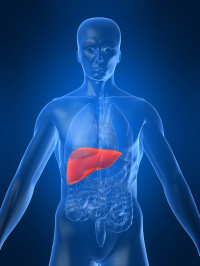Liver disease is an umbrella term for many diseases that affect the liver, the largest organ in your body. It’s on your right side, just under the bottom of your rib cage. Your liver plays an important role in your survival and you must have a liver to live, although you may be able to live with a partial liver. The liver actually has the ability to regenerate or grow back if not too much of it is damaged or removed.

Your liver processes or breaks down (metabolizes) many chemicals including nutrients, alcohol, and many drugs. It also:
- Makes important proteins
- Makes, stores, and processes fats and cholesterol
- Helps fight infections
- Metabolizes (breaks down) and stores carbohydrates for energy
- Makes and sends out bile, a greenish liquid that helps your intestine take nutrients from the food you eat
Certain liver diseases, such as cirrhosis of the liver, can increase your risk of developing and infection and sepsis.
Sepsis, which was often called blood poisoning, is the body’s life-threatening response to infection. Like strokes or heart attacks, sepsis is a medical emergency that requires rapid diagnosis and treatment.
Sepsis and septic shock can result from an infection anywhere in the body, such as pneumonia, influenza, or urinary tract infections. Worldwide, one-third of people who develop sepsis die. Many who do survive are left with life-changing effects, such as post-traumatic stress disorder (PTSD), chronic pain and fatigue, organ dysfunction (organs don’t work properly), and/or amputations.
What is cirrhosis of the liver?
In cirrhosis of the liver, the liver tissue begins to break down or deteriorate. Scar tissue then replaces previously healthy tissue. The scar tissue doesn’t allow blood flow through to the still healthy parts of the liver.
The damaged parts of the liver may regenerate in the early stages of the disease.However as the damage increases, the liver’s ability to fix itself drops until it can’t do so any longer.
How do you get cirrhosis of the liver?
Cirrhosis of the liver is a chronic (long-standing) liver disease. In North America, the most common causes of cirrhosis of the liver are alcohol abuse and hepatitis C infection. A few of many other causes include:
- Hepatitis B and hepatitis D
- Nonalcoholic fatty liver disease
- Infections
- Certain inherited diseases
Symptoms
As with many other illnesses, cirrhosis of the liver doesn’t often show early symptoms, so you could have it in the early stages and not know. Once symptoms do begin, they include:
- Weakness and fatigue
- Loss of appetite
- Nausea, vomiting
- Weight loss
- Abdominal pain
- Bloating in the abdomen
- Itching
- Spider-like blood vessels on the skin
Is there treatment?
There is no cure for cirrhosis of the liver but it can be managed if the damage to the liver tissue isn’t too severe. Lifestyle changes may prevent further progression of the disease and medications may treat symptoms or complications caused by the cirrhosis.
- Avoid alcohol and “recreational” drugs, they are metabolized in the liver
- Eat a nutritious diet, perhaps with supplements
- Limit salt intake
- Avoid medications metabolized (broken down) in the liver
Preventing cirrhosis
Some types of cirrhosis of the liver can’t be prevented. But the type that caused by long-term alcohol abuse or drug abuse can.
To avoid developing hepatitis, ensure you have up-to-date vaccinations for hepatitis A and B. Healthcare workers must receive hepatitis vaccinations because of their frequent exposure to possibly contaminated body fluids.
Hepatitis C does not have a vaccine, but can be prevented by:
- Practicing safe sex: use condoms each and every time you have sexual relations
- Not sharing needles. Don’t share personal items, such as toothbrushes, particularly if the other person has hepatitis.
- Using gloves (and dispose of them properly) if handling blood
If you suspect sepsis, call 9-1-1 or go to a hospital and tell your medical professional, “I AM CONCERNED ABOUT SEPSIS.”

The information here is also available as a Sepsis Information Guide, which is a downloadable format for easier printing.
Would you like to share your story about sepsis or read about others who have had sepsis? Please visit Faces of Sepsis, where you will find hundreds of stories from survivors and tributes to those who died from sepsis.
Updated April 20, 2023.































